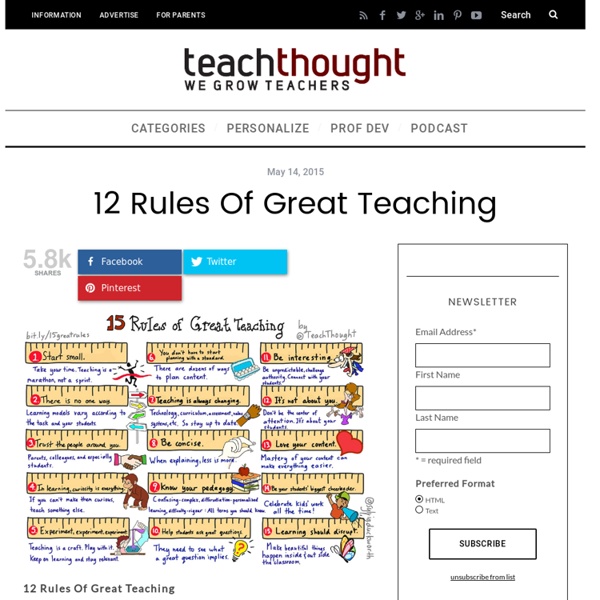Peut-on lutter contre l'incitation à la haine sur les réseaux ?
Peut-on lutter contre l'incitation à la haine sur les réseaux ? «S rjr sr Fcbk d l mrt d’n mgrnt, c’st hntx, nhmn t llgl.» Ss c ttr, l «cp d gl» d l rdctn d Frnc 3 Nrd-Ps-d-Cls fc dfrlmnt d cmmntrs hnx sr s pg Fcbk près l pblctn d’n rtcl sr l mrt d’n mgrnt Cls. Prm l flt d rctns : «Yp !», «Chmpgn» ncr «Ll». t l phnmèn, xplq l rdctn d Frnc 3 Nrd-Ps-d-Cls, n’ rn d’ndt. n fft, dps plsrs ms, ls tnsns tr d l «Jngl» d Cls nt trv n trrn d’xprssn sr ls rsx scx t ntmmnt sr Fcbk.
Tools for Educators - templates
10 Great Critical Thinking Activities That Engage Your Students
How can students own their learning with critical thinking activities they’ll really love? Allowing our students to take stands on issues that matter to them engages the classroom in a way that fosters great critical thinking. Who? What? 10 Great Critical Thinking Activities Let’s get to the critical thinking skills that really matter. Attribute Linking—Building Community by Taking Perspectives Students pair up according to similar physical attributes determined by the facilitator. Barometer—Taking a Stand on Controversial Issues When posed with a thought-provoking prompt, students line themselves up along a U-shaped continuum representing where they stand on that issue. Big Paper—Building a Silent Conversation Writing (or drawing) and silence are used as tools to slow down thinking and allow for silent reflection, unfiltered. Students can write at will, but it must be done in silence after a reflection on the driving question. Body Sculpting—Using Theatre to Explore Important Ideas
free business presentation software animated video maker and PowerPoint alternative
Prévenir la radicalisation en milieu scolaire - Prévention de la radicalisation
Enjeux du plan de prévention Contexte et acteurs du plan d'actions de prévention Depuis la mise en place de la politique de lutte contre la radicalisation violente et les filières terroristes, sous l'égide du ministère de l'intérieur, le 23 avril 2014 (circulaire aux préfets en date du 29 avril 2014), le secrétariat général du comité interministériel de prévention de la délinquance et de la radicalisation (SG-CIPD-R) est chargé de l'appui méthodologique et cordonne le plan d'actions de la prévention, avec les ministères concernés dont le ministère de l'éducation nationale, de l'enseignement supérieur et de la recherche (MENESR). La circulaire du Premier ministre du 13 mai 2016 a renforcé l'ensemble du dispositif à l'échelon territorial afin de développer la politique de prévention mise en place depuis 2014. Le dispositif mis en place par le ministère de l'intérieur s'appuie sur : Définition de la radicalisation Les actions du plan Prévention Repérage et signalement des jeunes Suivi des jeunes
AnswerGarden - Plant a Question, Grow Answers! Generate a live word cloud with your audience.
Topic (required) Type the topic of your new AnswerGarden. This can be a question or a topic, such as: "What do you think of my website?" More options (optional) For your convenience, you can change the following settings for your new AnswerGarden. AnswerGarden Mode In Classroom Mode respondents can submit an unlimited number of answers, but may only submit each answer once. Answer Length You can set the answer length to 20 or 40 characters. Admin Password You can enter a password that enables you to edit this AnswerGarden (such as the topic, unwanted answers and mode) afterwards. Show password Reminder Email Enter an email address and you'll receive an email containing the AnswerGarden link and admin password. It's ok to send me very occasional news about AnswerGarden. Spam Filter Filter that detects and removes common unwanted answers is now turned off. Case For readability, AnswerGarden changes the case of all answers to lowercase. Example: Hello and hello are grouped as hello.
Outils - GreenCréerDesLivres
(14/10/2012): actualisation des tutoriels Scribus Les tutoriels portent maintenant sur la dernière version de Scribus. Deux nouveaux tutoriels ont été ajoutés. Avec cette nouvelle version, vous pouvez réaliser des documents tels que ceux présentés ici. Les livres de la section littérature jeunesse peuvent être réalisés avec différents logiciels: Publisher en association avec word ou Scribus en association avec Open OfficePour chaque logiciel, nous vous proposons un tutoriel et des gabarits de livres Gabarits de livres Tutoriels: Comment utiliser ces gabarits Publisher jusque la version 2007 Publisher 2010 Scribus est un logiciel libre qui permet de réaliser des livres. Tutoriel n°1 : Premiers pas avec Scribus Tutoriel n°2 : Un premier livre Tutoriel n°3 : Créer des gabarits de page Tutoriel n°4 : Un livre complet avec une couverture Tutoriel n°5 : Créer une table des matières Tutoriel n°6 : Créer un formulaire PDF
Émotions (bases neurophysiologiques)
Le cerveau permet la mise en oeuvre des fonctions cognitives. Le terme cognition désigne tout ce qui se rapporte à la connaissance. Le cerveau permet également le processus émotionnel. L'émotion est le trouble intense de l’affectivité, une réaction immédiate, le plus souvent incontrôlée. L'émotion a un impact direct sur un individu. La valence avec la notion de positif ou agréable, négatif ou désagréable.L'alerte aboutissant chez un individu à une tension ou bien le calme.Le contrôle dont la caractéristique essentielle étant la possibilité ou l'impossibilité de réagir confrontée à une frayeur importante. Bases neurobiologiques des émotions De nombreuses structures du cerveau participent à la physiologie des émotions . Le système limbique est une région du cerveau qui est constituée par la circonvolution du corps calleux c'est-à-dire la circonvolution de Broca associée à celle de l'hippocampe. L'hippocampe, parmi ces structures, joue un rôle primordial.



